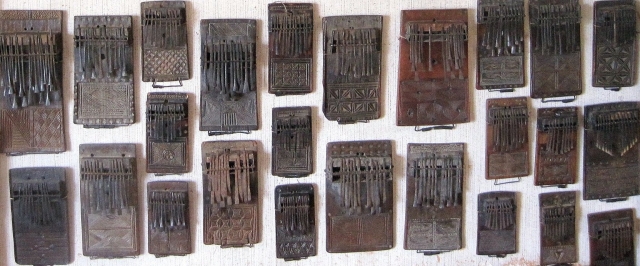An impressive and remarkable set of sanzas has been added to the King Baudouin Foundation collection thanks to the Marie-Jeanne Dauchy Fund.
A passionate collector’s life
Some 600 sanzas were patiently collected over more than 50 years by a couple of demanding Belgian collectors, Mr and Mrs Boulanger-Bouhière. Driven by a shared passion for African musical instruments and for this instrument in particular, these collectors scoured galleries, art salons and art dealers in Africa and elsewhere in search of museum-quality instruments. They lived with their sizeable collection covering their walls and shelves, adding to it rigorously year after year, and documenting it with a thorough and meticulous inventory. On several occasions, interest in the high quality of the entire collection gave rise to exhibits in museums at home and abroad.
An evocative and identity-linked musical instrument
Sanzas are traditional musical instruments of the idiophone family typical of sub-Saharan Africa. These lamellaphones are always made of a wooden base, sometimes with a resonator, and fitted with a bridge to which different-sized metal or bamboo lamellae, or tines, are attached. They are sometimes accompanied by other vibrating components in metal, glass, stone or shell. The instrument is played with the fingers of both hands. The sounds and melodies played by the sanza are directly and symbolically associated with that part of the world. In addition to its recreational and musical function, intended to accompany dances or speeches of the ancestors, the melody of the sanza is sometimes essential for rituals and to call for rain.
An extraordinary and exhaustive stylistic repertoire
The main value of these several hundred sanzas, some of which are more than 1,000 years old, is as a sign of the historical, artistic and stylistic richness typical of a particular geographical region. With their apparent simplicity, the instruments serve as the basis for the extraordinary creativity of the craftsperson who undertook the creation of various carved and sculpted ornaments, which carry an immense symbolism, with each motif having its own meaning and allusions. This collection is unique in the world, representing an important heritage and attesting to the typological diversity of these evocative musical instruments that have disappeared from daily musical life in Africa since the end of the 1960s.
Two museums to safeguard a collection with an international reputation
The collectors responded enthusiastically to the joint proposal and decision of the Musical Instrument Museum (MIM) in Brussels and the Musée de la Musique in Paris to share and jointly exhibit this formidable and rare collection. As a result, 300 selected sanzas, with their references, have been acquired by the King Baudouin Foundation via the Marie-Jeanne Dauchy Fund, and entrusted to the collections of the MIM. The other part of the collection was purchased with the funds of the Musée de la Musique in Paris.
